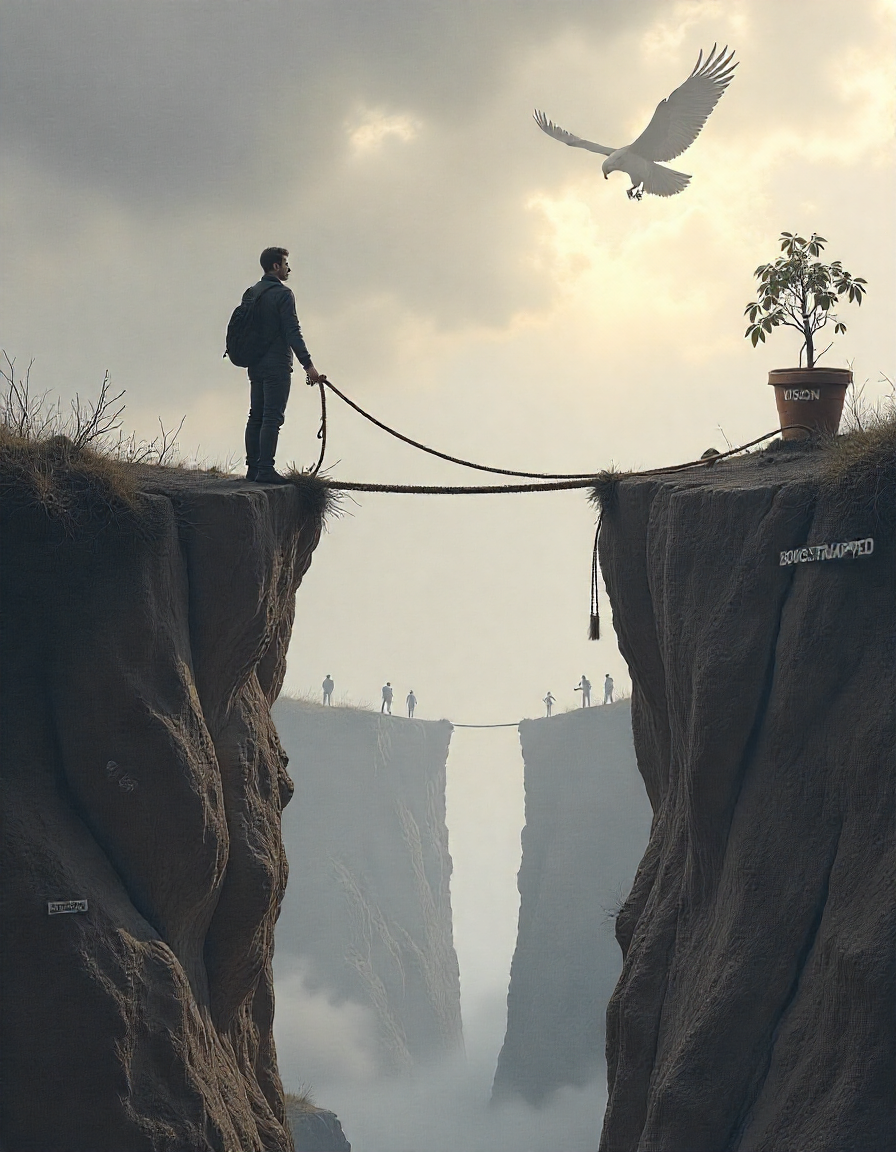The Unfiltered Truth About Building a Startup: Beyond the Hype

The fluorescent lights of the co-working space flickered at 2:17 AM as Sarah wiped coffee stains off her third notebook of the night. Her startup, a platform connecting local farmers directly with urban consumers, had just lost its biggest potential investor. Two years of her life, $80,000 in personal savings, and countless sacrificed weekends hung in the balance. This wasn’t the glamorous “founder journey” portrayed in tech blogs – this was the raw, unglamorous reality that 90% of entrepreneurs face but few discuss openly.
The Myth of Overnight Success
We’ve all heard the stories: college dropouts building billion-dollar companies from dorm rooms, apps that go viral overnight, founders who “just knew” their idea would change the world. These narratives dominate startup culture, creating dangerous misconceptions about what it actually takes to build something from nothing.
The reality looks more like this: consistent, grinding effort punctuated by moments of sheer terror. Take Instagram, often cited as an overnight sensation. What most people don’t realize is that Kevin Systrom spent two years building a failed check-in app called Burbn before pivoting to photo sharing. Even then, Instagram’s explosive growth required 18 months of relentless refinement before Facebook acquired it for $1 billion.
The startup landscape is littered with the graves of companies that seemed poised for success but couldn’t navigate the treacherous path between idea and sustainable business. According to recent studies, approximately 20% of new businesses fail during the first two years, 45% during the first five years, and 65% during the first ten years. These aren’t just statistics – they represent shattered dreams, depleted savings, and profound personal tolls.
Navigating the Valley of Death
Every startup journey inevitably leads through what investors call the “Valley of Death” – that perilous period between initial funding and achieving sustainable revenue. This is where most ventures perish, not because of bad ideas, but because of execution gaps.
Consider the case of a promising fintech startup that developed an innovative payment processing system. The technology was sound, the market need clear, and the founding team brilliant. Yet they collapsed within 18 months. Why? They burned through their seed funding acquiring customers without understanding their true lifetime value. They focused on growth metrics while ignoring unit economics. They hired too fast, built too much, and ran out of cash before finding product-market fit.
Surviving this valley requires more than passion – it demands brutal honesty about what’s working and what isn’t. Successful founders develop an almost obsessive relationship with their numbers. They know their customer acquisition cost inside out, track churn rates weekly, and can tell you exactly how much runway they have left with terrifying precision.
The Human Cost of Entrepreneurship
Behind every pitch deck and funding announcement are human stories rarely told. The psychological toll of startup life is profound. Studies show that entrepreneurs experience significantly higher rates of depression, anxiety, and substance abuse than the general population. The constant pressure, financial uncertainty, and weight of responsibility for employees’ livelihoods create a perfect storm of stress.
Mark, founder of a now-successful SaaS company, recalls the darkest period: “I hadn’t slept more than four hours a night in months. My wife left me. I was $120,000 in credit card debt. One morning, I found myself sitting in my car outside the office, unable to go in, literally shaking. That’s when I knew something had to change.”
The startup culture often glorifies hustle and sacrifice, celebrating founders who work 100-hour weeks and sleep in their offices. But this narrative ignores the diminishing returns of exhaustion and the creativity-killing effects of burnout. The most successful entrepreneurs I’ve interviewed eventually learn that sustainable performance requires boundaries, rest, and perspective.
Building the Right Team
Perhaps the most critical factor in startup success – and the most commonly mishandled – is team dynamics. Co-founder conflicts destroy more startups than competition or market changes. The excitement of starting something together often masks fundamental differences in work style, risk tolerance, and long-term vision.
When Maya and Raj launched their e-commerce platform, they were inseparable friends and business partners. Within 18 months, they weren’t speaking. “We never discussed what would happen if one of us wanted to pivot and the other didn’t,” Maya explains. “We never established clear decision-making processes. We just assumed our friendship would carry us through. It nearly destroyed both our business and our relationship.”
Successful founding teams spend as much time discussing their working relationship as their business model. They define roles clearly, establish conflict resolution mechanisms before disagreements arise, and regularly check in on their partnership health. They recognize that business is personal, and ignoring the human element jeopardizes everything.
The Customer Development Paradox
One of the most counterintuitive truths in startups is that your initial assumptions about customers are almost always wrong. Yet founders often cling desperately to their original vision, ignoring what the market is desperately trying to tell them.
The lean startup methodology popularized the concept of “getting out of the building” – talking to potential customers early and often. But what most miss is how to truly listen. It’s not about conducting surveys or running focus groups; it’s about observing behavior, reading between the lines of what people say, and identifying the jobs customers are actually trying to do.
A health tech startup learned this lesson the hard way. They spent months building a sophisticated nutrition tracking app based on what users said they wanted. After launch, adoption was abysmal. Only through painful observation did they realize that while people claimed to want detailed nutrition data, their actual behavior showed they wanted simple, habit-based guidance. The company survived only by completely rebuilding their product around actual user behavior rather than stated preferences.
The Art of the Pivot
The ability to pivot – to make a significant course correction while maintaining vision – separates enduring startups from fleeting ones. But pivoting isn’t just changing features or target markets; it’s a fundamental reassessment of the business model based on hard-earned insights.
Consider Slack, now a ubiquitous workplace communication tool. It began life as a gaming company called Tiny Speck. The game itself failed, but the internal communication tool the team built to coordinate their distributed work showed unexpected promise. Recognizing this, the founders made the painful decision to abandon their original vision and focus entirely on the communication tool. That pivot transformed a failing game company into a business eventually acquired for $27.8 billion.
Pivoting requires intellectual honesty, courage, and the ability to separate identity from idea. Founders who can’t let go of their original concept, even when evidence mounts against it, doom their companies to irrelevance.
The Long Game
In a culture obsessed with rapid growth and hockey-stick curves, we often forget that most meaningful businesses take time to build. The companies that truly change industries rarely do it overnight. They compound small advantages over years, gradually building defensible moats around their business.
Patagonia, now a billion-dollar outdoor clothing company, spent its first decade barely scraping by. Founder Yvon Chouinard focused obsessively on product quality and environmental responsibility, reinvesting profits rather than chasing growth. This slow, deliberate approach created a brand with authentic values and customer loyalty that money can’t buy.
The startup ecosystem needs more stories like this – narratives of persistence, adaptation, and sustainable building. We need to celebrate the founders who choose profitability over vanity metrics, who prioritize company culture over rapid scaling, who understand that real value creation is a marathon, not a sprint.
A New Startup Narrative
As we reshape our understanding of entrepreneurship, perhaps it’s time to retire the myths and embrace a more honest narrative. Building a startup isn’t for everyone, and that’s okay. The journey involves far more failure than success, more doubt than certainty, more sacrifice than reward – at least initially.
But for those with the resilience to continue, the clarity to learn from mistakes, and the wisdom to build sustainably, entrepreneurship remains one of the most powerful ways to create value in the world. The true startup story isn’t about unicorns and exits; it’s about solving real problems for real people, one difficult day at a time.
Sarah, the founder we met at the beginning, eventually found her way through. After losing that investor, she made painful cuts, refocused on her most profitable customer segment, and slowly rebuilt. Five years later, her farm-to-table platform serves 12 cities, supports 300 small farms, and has never taken venture capital. “The hardest thing was letting go of the glamorous startup fantasy,” she reflects. “Once I accepted that this was just hard work – important, meaningful work – everything changed.”
That’s the unfiltered truth about building a startup: it’s not a fairy tale, but for those willing to embrace reality, it can be something far more valuable – a lasting contribution that actually matters.



